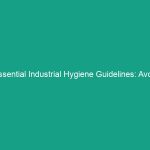Good morning team!
Today, we’re diving into a critical topic that affects not only our Environment but also our Safety and efficiency on the job—Essential Sustainable Transportation Guidelines: Avoid Common Pitfalls. Understanding and implementing these guidelines is vital for minimizing risks associated with transportation in our work processes.
Understanding Essential Sustainable Transportation Guidelines
Essential sustainable transportation guidelines refer to practices and principles that promote safe, efficient, and environmentally friendly transportation methods within the workplace. These guidelines are important because they directly influence our daily operations, helping us reduce emissions, save energy, and enhance Safety.
Many people believe that sustainable transportation is solely about using electric vehicles or public transit; however, it’s much broader. It encompasses all aspects of how we transport ourselves and goods, including route planning, vehicle Maintenance, and the choices we make regarding transportation methods.
Key Hazards, Risks, and Safety Considerations
When discussing sustainable transportation, it’s crucial to recognize the potential Hazards and risks involved:
- Vehicle Safety: Poorly maintained vehicles can lead to accidents and breakdowns, posing risks to employees.
- Environmental Impact: Inefficient transportation methods contribute to pollution and increased carbon footprint.
- Personal Safety: Commuting hazards such as Distracted Driving or inadequate pedestrian pathways can lead to injuries.
Ignoring these safety protocols can have real-world consequences, including accidents resulting in injuries, increased costs due to vehicle repairs, and a negative impact on our company’s reputation.
Best Practices, Procedures, & Actionable Advice
To ensure we adhere to the essential sustainable transportation guidelines, here are some Best Practices and actionable steps:
1. Vehicle Maintenance
Regular vehicle inspections and maintenance are crucial. Ensure that:
- All vehicles undergo routine checks for tire pressure, brakes, and lights.
- Oil changes and engine checks are performed at recommended intervals.
2. Route Optimization
Planning efficient routes can reduce fuel consumption and time spent on the road. Consider using:
- GPS navigation systems that provide real-time traffic updates.
- Software tools that help in planning the most efficient delivery routes.
3. Training and Awareness
Regular Training sessions can help employees understand the importance of sustainable transportation. Topics can include:
- Safe driving practices.
- Environmental awareness related to transportation choices.
4. Promote Alternative Transportation
Encourage the use of alternative transportation methods such as:
- Carpooling to reduce the number of vehicles on the road.
- Using bicycles for short distances when feasible.
- Utilizing public transit options for commuting.
For example, a company that implemented a bicycle-to-work program saw a significant reduction in parking congestion and improved employee health.
Regulations, Standards, and Compliance
It’s essential to be aware of and comply with relevant safety Regulations, such as those set by OSHA and ISO. Compliance not only protects employees but also enhances our operational efficiency and reduces potential legal liabilities.
Familiarize yourself with these regulations and ensure that all transportation practices align with them. Regular audits can help identify areas for improvement.
Employee Engagement & Discussion
Now, let’s open the floor for discussion. Here are some questions to consider:
- What safety challenges have you encountered related to transportation at work?
- How can we improve our current transportation practices?
Your insights are invaluable, and sharing experiences can lead to collective learning and implementation of better practices.
Conclusion & Key Takeaways
To wrap up, remember that implementing essential sustainable transportation guidelines is not just a checkbox; it’s a commitment to safety, efficiency, and environmental stewardship. Here are the key takeaways:
- Prioritize vehicle maintenance and inspections.
- Optimize routes to enhance efficiency.
- Promote training and alternative transportation options.
- Stay compliant with safety regulations.
Let’s all commit to making our transportation practices safer and more sustainable. Thank you for your attention and your dedication to maintaining a safe work environment. Together, we can avoid common pitfalls and lead by example!


